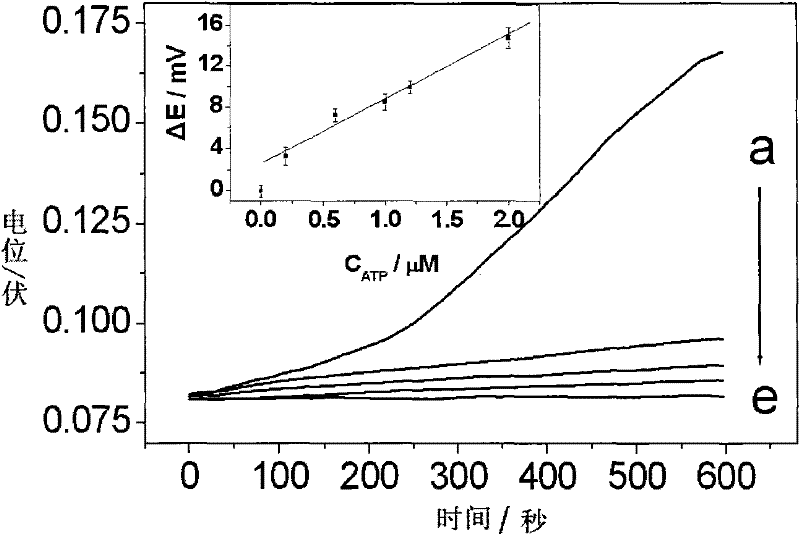A detection method and device of a polymer membrane ion selective electrode
An ion-selective, polymer membrane technology, used in measuring devices, material analysis by electromagnetic means, instruments, etc., can solve the problems of cumbersome operation process, and achieve the effect of good selectivity, wide application range and rich variety
- Summary
- Abstract
- Description
- Claims
- Application Information
AI Technical Summary
Problems solved by technology
Method used
Image
Examples
Embodiment 1
[0031] like figure 1 As shown, the polymer membrane ion selective electrode detection device of the present invention includes a detection cell 9 , a polycation selective electrode 4 , an internal reference electrode 1 and an external reference electrode 5 . Among them, the detection pool 9 is a container for containing the measured object; the polycation selective electrode 4 is a working electrode, which contains an internal filling liquid 2 and a polymer sensitive film 3 at the bottom; one end of the internal reference electrode 1 is inserted into the Inside the polycation selective electrode 4, the other end is connected to an external potential measuring device; one end of the external reference electrode 5 is set in the detection cell 9, and the other end is connected to the external potential measuring device.
[0032] like figure 2 As shown, the polycation selective electrode 4 in this embodiment can also be connected to the rotating electrode head of the rotating di...
Embodiment 2
[0049] In this embodiment, the determination of potassium ions by titration is an example, and its determination steps are as follows:
[0050] a. 5.0mL pH 7.4 tris buffer solution containing 0.12M sodium chloride, add 2×10 -6 M potassium aptamer, the base sequence of the aptamer is 5'-GGTTGGTGTGGTTGG-3', insert the polycation selective electrode 4 into the above solution, and add 5 μL of 1 mg / mL protamine in sequence every two minutes , to record the potential real-time response;
[0051] b. Add 2×10 -6 M potassium aptamers were combined with 5×10 -6 M, 10 -5 M, 5×10 -5 M, 10 -4 M, 5×10 -4 M potassium ions, after 20 minutes of interaction between the two, insert the polycation selective electrode 4 into the above solution, and add 5 μL of 1 mg / mL protamine successively at intervals of every two minutes, and record the real-time response of the potential, as shown in FIG. Figure 4 shown;
[0052] c. Using the concentration of protamine corresponding to half of the max...
Embodiment 3
[0055] The difference from Example 1 is that this example takes adenosine triphosphate (ATP) aptamer as the substrate of nuclease, and measures the activity of nuclease as an example. The buffer solution is pH 4.6 acetic acid-sodium acetate buffer containing 0.15M sodium chloride and 0.001M zinc sulfate.
[0056] Its measurement steps are as follows:
[0057] a. 3.0mL pH 4.6 acetic acid-sodium acetate buffer solution containing 0.15M sodium chloride and 0.001M zinc sulfate contains 10 -6 M Adenosine triphosphate (ATP) aptamer, the base sequence is 5'-ACCTGGGGGA GTATT GCGGA GGAAG GT-3', after adding 26.7 μg / mL protamine and interacting with the two for 10 minutes, the polycation selective electrode 4 Insert the above solution, record the real-time potential response of the polycation electrode, and use the electrode potential value at 10 minutes as the control signal;
[0058] b. In 3.0mL of the above buffer solution, 1U / mL, 5U / mL, 10U / mL, 30U / mL, 50U / mL of nuclease were mixe...
PUM
 Login to View More
Login to View More Abstract
Description
Claims
Application Information
 Login to View More
Login to View More - R&D
- Intellectual Property
- Life Sciences
- Materials
- Tech Scout
- Unparalleled Data Quality
- Higher Quality Content
- 60% Fewer Hallucinations
Browse by: Latest US Patents, China's latest patents, Technical Efficacy Thesaurus, Application Domain, Technology Topic, Popular Technical Reports.
© 2025 PatSnap. All rights reserved.Legal|Privacy policy|Modern Slavery Act Transparency Statement|Sitemap|About US| Contact US: help@patsnap.com



